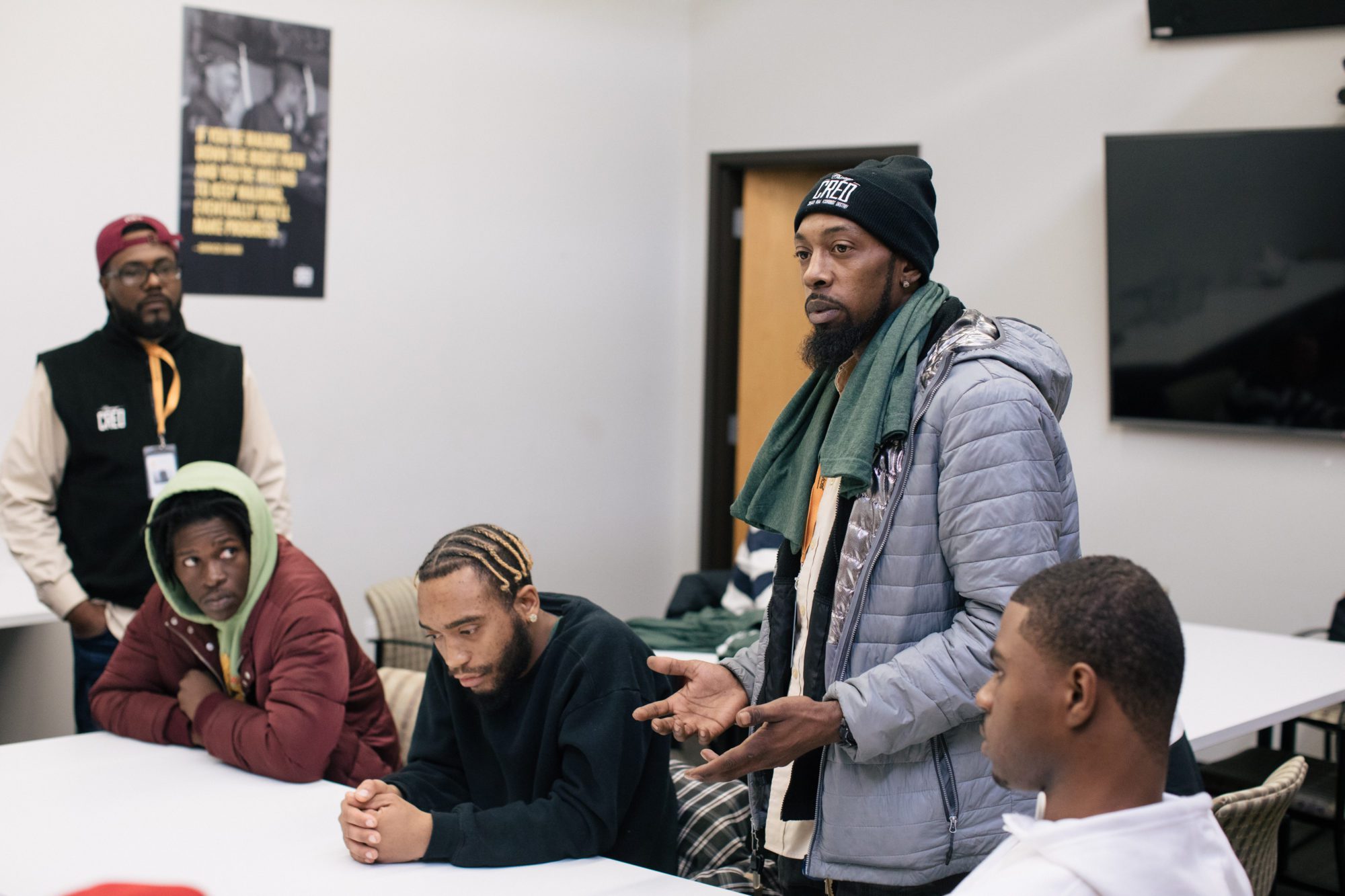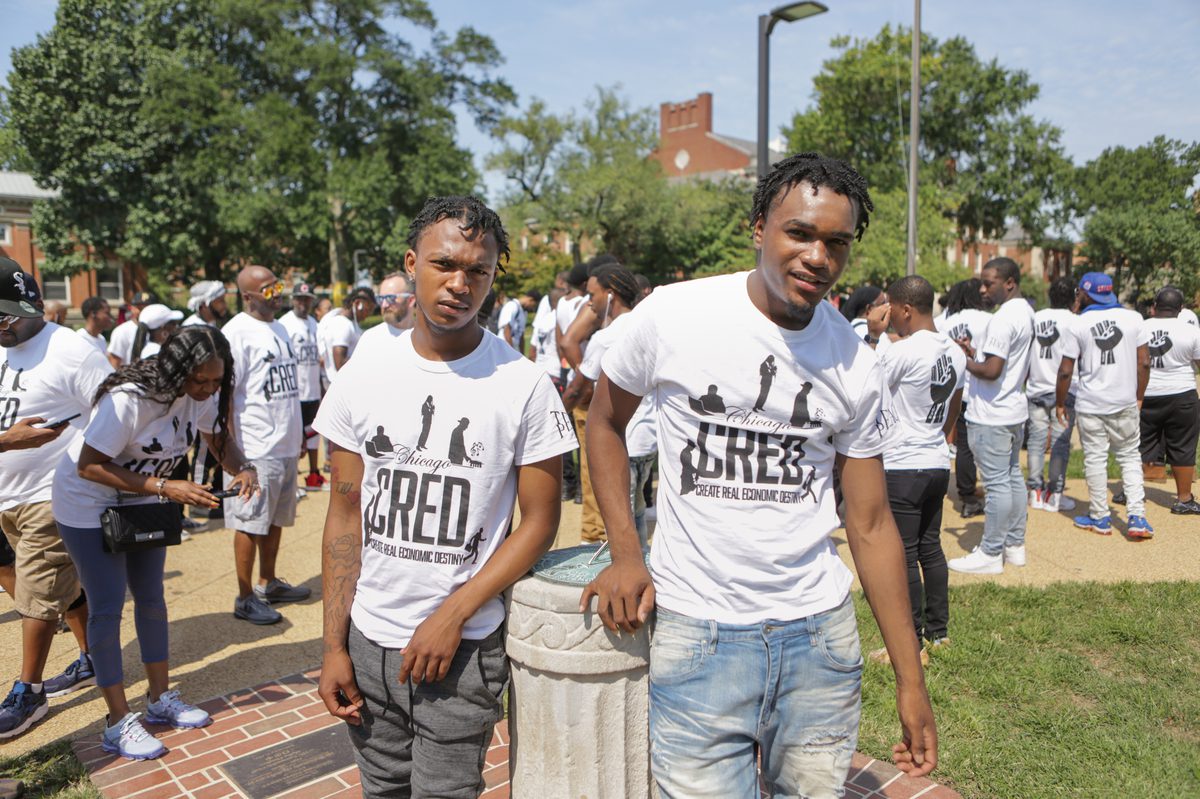In Chicago Mayor Race, Policing Dominates Over Violence Prevention Programs
Violence prevention organizations make the case for drastically scaling up and expanding their approach to solving shootings and murders in the city. Will the next mayor back them with serious investment?
| February 16, 2023

On a brisk and sunny February morning, 22-year-old Keyon Pass approached a microphone in a packed South Shore ballroom to tell his story of survival. “I’d always been athletic and smart, but society got the best of me for a while,” Pass, wearing matching gray Nike sweatpants and sweatshirt, said to a crowd of hundreds gathered to discuss gun violence prevention. Pass explained how he started stealing cars as a teenager growing up on the city’s West Side, and how as a young adult he had lost close friends and family in shootings that left him traumatized.
“I found myself numb to death because it was so normal to me,” he said. “I had nothing to lose and nobody to talk to me about it.”
Pass choked up, and the crowd clapped and cheered him on, as he described how his life transformed when he decided to become a participant in Chicago CRED (Create Real Economic Destiny), a non-profit that prevents gun violence by deploying intensive services, ranging from life coaching, therapy for trauma, stable employment, and a weekly stipend of $125 to $225 over the course of two years. Chicago CRED participants like Pass face extraordinary risks of committing a shooting or being shot themselves, sometimes both simultaneously. Research shows that young adult males living in Chicago’s most dangerous zip codes face substantially higher risks of firearm-related homicide than U.S. soldiers deployed to the Iraq and Afghanistan wars.
“I wouldn’t be here without [the] Chicago CRED family,” Pass told the crowd of violence prevention outreach workers, academic researchers, Chicago business leaders, as well as law enforcement and public health officials from the city.
Crime and public safety remain top of mind for Chicago voters who will elect their next major during the Feb. 28 election. But the hardships and trauma of the city’s young people have rarely translated into effective political action that creates lasting change for the neighborhoods most directly harmed by gun violence.
In the remaining weeks of the election, Chicago’s political debate over crime and safety is caught between calls for harsher punishment and expanded policing versus addressing the trauma and stark inequality driving crime and violence. In a crowded field of nine candidates, all have given lip service to community violence intervention groups, but few have advocated for more funding for programs like CRED that have been proven to reduce gun violence, while other candidates are calling for additional funds for police.
If none of the nine candidates win more than 50 percent of the vote in the first round, the two top candidates face a runoff held on April 4. Incumbent Mayor Lori Lightfoot, whose own record on gun violence is under close scrutiny, could be the city’s first mayor to lose re-election in 34 years.
“People who pick up a gun and wreak havoc in a neighborhood, they need to be locked up. Period, full stop,” Lightfoot told Politico in a Feb. 2023 interview.
Former CEO of Chicago Public Schools Paul Vallas, running to the right of Lightfoot and endorsed by the notoriously brash police union, promises to address crime by hiring more police officers to patrol the streets and prosecuting more low-level “nuisance” crimes. Candidates running to the left of Lightfoot, like Brandon Johnson, endorsed by the powerful teachers union, argue Lightfoot has failed to address the root causes of violence in the city’s South and West Sides, and says more police does not result in safer neighborhoods.
“The root of the problem is we’re dealing with young people that are traumatized,” Chicago CRED’s housing coordinator Kanoya Ali told Bolts. “Many of them have lost 20 friends and they’re not 20 years old.”
Violence prevention organizations, however, are urging politicians to embrace a vision for public safety that goes beyond incarceration.
“Violence intervention programs are an important harm reduction strategy that has to be funded to scale—full stop,” Stephanie Kollmann, policy director at Northwestern’s Children Family Justice Center, told Bolts. “If you want healthy families, safe communities, and more people engaged in the legal economy, they need stable housing, quality education and healthcare, decent jobs, and good recreational experiences—those are the strongest form of violence prevention policy that we can create.”
Community violence intervention groups work, in a broad sense, by inspiring hope and a promise of a better life. Research by the University of Chicago and Northwestern University shows that participants in Chicago’s violence prevention groups—like CRED and READI (Rapid Employment and Development Initiative)—experience substantial reductions in arrests for shootings, homicide, and being a victim of gun violence. And because shootings are so costly to cities, programs like READI also generate massive social savings, between $174,000 and $858,000 per participant, researchers estimate.
“People that are involved in CRED, if they finish the program, they live longer and they stay out of jail longer,” Andrew Papachristos, professor of sociology at Northwestern University who studies violence prevention groups, told Bolts. “The program we evaluated happened during Covid and a national spike in gun violence. By any realistic, non-political standard, that’s a pretty big success.”
“From a political standpoint, I think it should be a win, too,” Papachristos added.
Homicides are down nearly 15 percent since 2021, the most violent year in Chicago since the crime wave of the 1990s. Still, the level of homicides remains exceedingly high: Chicago has had more than 400 homicides every year running since 1965—a 58-year streak.
“Our goals are very ambitious,” Teny Gross, executive director of the Institute for Nonviolence Chicago, told Bolts. “We want to have an 80 percent reduction in the next 15 years.” For that to happen, Gross says that means more outreach workers, more case managers and more clinicians, on top of addressing the damage done by neighborhood disinvestment. “The difference I see in Chicago between the ‘don’t haves’ and ‘the haves’ is unbelievable,” Gross said. “It’s a man-made crisis.”
Doctor Selwyn Rogers, the founding director of the University of Chicago Emergency Department and Trauma Center on the South Side, witnesses first-hand the brutal physicality inflicted by gun violence on human beings everyday. Rogers similarly described gun violence in Chicago as a “Tale of Two Cities.” On the one hand, gun violence is “hyper-endemic” in some communities while close to non-existent in others.

Just six neighborhoods out of 77—comprising less than one tenth of the city’s population—accounted for a third of all of Chicago’s shootings in 2021. The majority of victims, by far, are Black men and women on the city’s South and West Sides, born into neighborhoods beset by high levels of homelessness, unemployment, substance use, hunger, and crumbling infrastructure, from schools to public parks, resulting from decades of divestment and neglect. The fact that the South and West Sides neighborhoods, where violence is most concentrated, have low voter turnout also complicates the politics of gun violence in the city; research shows that the most policed neighborhoods also vote less.
These problems, structural and deeply entrenched, touch just about every aspect of civic life, and are a result of decades of de jure and de facto racial segregation that has characterized most of Chicago’s history. But their impacts, Rogers warns, are not relegated to the past nor just these neighborhoods.
“This is not a ‘they’ problem,” Rogers told Bolts. “This is a ‘we’ problem. Irrespective of your politics, this is all of our problem.”
When people get shot and are brought to the trauma center where Rogers works, they receive expensive health care. “Who pays for that?” Rogers asked. “We all do.” More importantly than the financial burden for Rogers is the loss of human potential. Without addressing chronic disinvestment in these hard-hit communities, Rogers thinks there’s little chance of solving crime and violence in the city.“ How many people do we lose that could’ve done something different with their lives? How many people lose hope in the morass of violence?”
All of the mayoral candidates publicly support community violence intervention, no matter their broader stance on crime. But few have offered detailed plans.
For Paul Vallas, one of the frontrunners in the race, this looks like an increased role for educational systems as an intervening force, as well as more police.
“We need to embrace violence reduction strategies like CRED, and we need to open our school campuses,” Vallas said in response to a question about his plan to address public safety. Vallas is running a “tough on crime” campaign and continuously calls to rebuild the police force and expand “community policing.”
Jesús “Chuy” García, who also promises to hire more police officers, said that violence prevention groups are doing “God’s work,” and that more investment in community violence programs is “critical to the well-being of communities.” García, the other top candidate alongside Lightfoot and Vallas, has a public safety plan similar to Lightfoot’s, though he says the city can better implement an effective strategy under his leadership.
Lightfoot, meanwhile, has struggled to defend herself from a barrage of criticism coming from all sides. Community activists are frustrated over low levels of funding for community-based violence prevention during Lightfoot’s tenure as mayor, all while she’s increased the police budget every year since she took office in 2019. During the candidate forum, Lightfoot touted her administration’s record on violence prevention programs. “When I came into office, we were funding about two million dollars a year,” Lightfoot said. “We’re now spending $58 million a year. The money is flowing to street outreach.” (City records indicate that $52 million was allocated to violence intervention annually.)
Still, violence prevention groups only receive a tiny fraction of the funding that the police department receives. CPD’s budget is nearly $2 billion, and makes up over 65 percent of the city’s total spending on public safety. Chicago currently has more police officers per capita than any other major city except Washington D.C.
Mayoral candidate Brandon Johnson, favored by left-wing organizations, argues that the safest neighborhoods aren’t the most heavily policed. Instead, he says, those neighborhoods have robust infrastructure, from quality schools to affordable housing and public transportation. “We’re spending $5 million a day policing alone, and that hasn’t solved any of our systemic problems,” Johnson said. Johnson’s public safety plan does not include increasing the police budget or hiring more police officers.
According to a WBEZ and Sun-Times questionnaire, just two candidates—state Rep. Kam Buckner and activist Ja’Mal Green—said they would reallocate resources away from policing and toward the “root causes” of gun violence.
Gun violence prevention groups are now in the political spotlight, but at current funding levels, these groups are only reaching a small fraction of people who are at risk of being targeted by shooters.
“We have to keep scaling this work. We know we’re not at scale,” Arne Duncan, co-founder of Chicago CRED, who also served as CEO of Chicago Public Schools, as well as US Education Secretary, said. “There’s so many men and women and teens we’re not serving yet.”
Ali, of Chicago CRED, is skeptical of the political rhetoric coming from the candidates. “I don’t know how serious that politicians and policymakers are taking this,” he said. “What has to be said to them? These young people need a chance, an opportunity, to really grow and bring something back to the community. They are not liabilities, they are assets.”
Ali wonders how many more of the city’s young people have to die before Chicago is willing to fully commit to a holistic approach that treats gun violence through a compassionate, public health-focused lens.
While not often associated with enhancing public safety, the expansion of Medicaid, increased access to mental health care, and a guaranteed basic income have shown to reduce crime. Mayor Lightfoot’s latest budget did not include funding to extend Chicago’s universal basic income program, which cut $500 monthly checks to 5,000 Chicagoans facing economic hardships.
At the South Shore meeting on gun violence, the organizations presented a vision of safety that includes a role for law enforcement, but also transcends the narrow confines of policing, prosecution, and incarceration.
“This is the moment we need to reject fear,” said Gross. “You’ve already had more policing for the last 30 years. And more incarceration. We have the right to say we don’t want more of that.”
Gross added, “We need more peacekeepers.”

